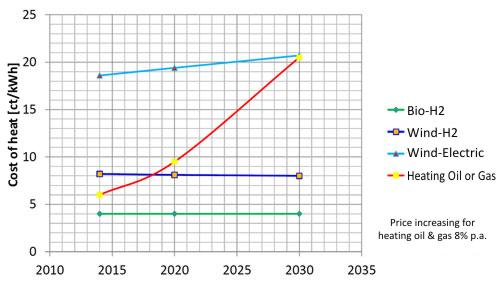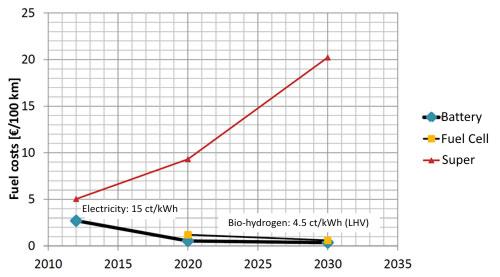
 |
|
|
|
True electricity prices (NOT YET FULLY EDITED) Fitting for a market economy which understands itself to be part of a democracy belongs the demand that prices for goods needed daily tell the truth. We are a long way from that for the price of electricity. A large portion of the electricity costs are paid for in Germany, Europe and the world from taxes and social funds. |
|
|
 |
|
True electricity costs for domestic customers in 2020 (without tax nor duties) The information about the production costs are taken from a study of the Fraunhofer ISE Institute [1]. In this case an average learning curve was chosen for wind and solar (PV) and no significant taxation of fossil fuels was assumed. The production costs for electricity refer to new power plants. Only the effect of writing off wind power plants was shown. The state subsidies have been added to conventionally produced electricity. The external or social costs of energy production have been taken from the study [1]. These come originally from the UBA (Umweltbundesamt - environment agency of Germany). The distribution costs for grid electricity came to 9.3 ct/kWh in 2009 and 11.2 ct/kWh in 2012 according to the Federal Grid Agency in Germany. These have been extrapolated to 12.5 ct/kWh for 2020. It is shocking to see that the major part of the cost (around 20 ct/kWh) for fossil based power plants today is not included in the electricity price, but is paid by the state and social budgets. A comparison of the true electricity costs shows that electricity from wind and solar is competitive already today. The figure also shows that the distribution of energy via the gas pipe network with around 1 ct/kWh in the form of hydrogen is significantly more cost efficient than grid distribution. At first glance it may seem that conversion of electricity by electrolysis is senseless, as expensive electricity is converted into a gas, which will only be half reconverted back to electricity using a fuel cell. Given a second glance one recognises that in the future hydrogen economy there will be too much electricity anyway, which will force electrical energy to be used for heating. A further result of this representation is that electricity produced directly from hydrogen from thermo-chemical gasification is significantly more cost-effective than from electrolysis. In total renewable energy sources will become even more cost-effective than they already are by integrating them into a hydrogen economy. The electricity prices shown are without tax and levies. For electricity from the grid these costs are around 10 ct/kWh today and for gas from the pipe network around 1 ct/kWh. The expected amount to be paid for coal-based electricity must be around 47 ct/kWh and for wind-based electricity from the national grid around 29 ct/kWh. For homemade wind electricity in contrast only 10 ct / kWh and for homemade electricity from bio-hydrogen around 4 ct/kWh. The price difference compared to coal-based electricity is therefore an order of magnitude! If ever more electricity is generated domestically, the distribution costs for the electricity grid will rise strongly, because the fixed costs have to be shared between ever fewer electricity customers. Therefore the gap between electricity from the national grid and from domestic production will continue to grow. Industrial electriciy from biomass is possible for around 3 ct/kWh. The price could be halved if the markets were to regain confidence in the real economy and bid farewell to commodity speculation. As a summary it is clear that climate protection negotiations are completely unnecessary and Germany as an industrial centre is in no way hindered by using renewable energy - the opposite is true. |
|
The growth of heating and fuel costs These two sectors do not indicate any benefit in keeping fossil-based energy carriers. Given price rises for fuel and gas of 8% each year, the cost of heating with wind will become cheaper than heating with oil or gas in a few years. Without doubt, future vehicles will have an electric drive. The costs shown below are without tax and levies. |
|||||||
 |
|||||||
 |
|||||||
|
Domestic heating costs Fuel costs for cars The boiler of the future will be a hydrogen boiler. This makes it possible to cover electricity needs at the same price from the start. That type of electricity producing boiler is even cheaper than modern pellet boilers. Even a boiler driven by wind-hydrogen is cheaper than a boiler running on natural gas or heating oil. The future of transport will be electric. For reasons of cost and efficiency it is irrelevant whether it is driven by batteries or fuel cells. Longer term, fuel cell drive trains offer more comfort for a lower cost. The internal combustion engine will in the medium or long term become unused. |
|||||||
|
updated: 05.07.2014 |
|||||||
|
Literature: [1] Fraunhofer ISE; Stromgestehungskosten erneuerbarer Energien; Studie November 2013 |
|||||||
|
|
|||||||